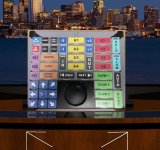I am asking this question because I do not have a tricaster to check out the included virtual sets....so, please be patient with me. I am about to pull the purchase plug and take the plunge.
I would like to do a virtual set which had one or two person(s) sitting at a green screen desk with a computer and coffee cup etc. I want the talent to be able to rest his or her arms on the virtual desk with reflections realistic blurring etc.
I have looked for detailed visuals of all of the virtual sets included to verify that at least one of the virtual sets permits this. My search produced three 404 pages so i have not been able to find detailed photographs.
Can you tell me if such a set is included and what its name is. I will then find it and make sure it works for what i will need to do.
Thank you
I appreciate your help as this is a confusing and powerful tool. Yes, I went to film school but they actually cut negatives back then!!!!
Rob
I would like to do a virtual set which had one or two person(s) sitting at a green screen desk with a computer and coffee cup etc. I want the talent to be able to rest his or her arms on the virtual desk with reflections realistic blurring etc.
I have looked for detailed visuals of all of the virtual sets included to verify that at least one of the virtual sets permits this. My search produced three 404 pages so i have not been able to find detailed photographs.
Can you tell me if such a set is included and what its name is. I will then find it and make sure it works for what i will need to do.
Thank you
I appreciate your help as this is a confusing and powerful tool. Yes, I went to film school but they actually cut negatives back then!!!!
Rob


